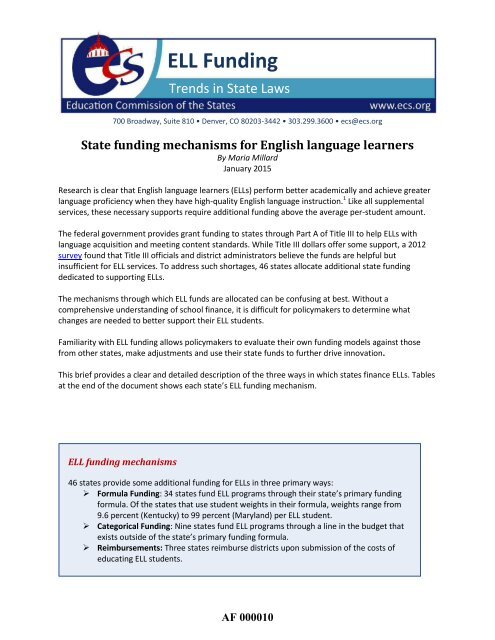11-30-Electronic-Cover-letter-and-Report
11-30-Electronic-Cover-letter-and-Report
11-30-Electronic-Cover-letter-and-Report
Create successful ePaper yourself
Turn your PDF publications into a flip-book with our unique Google optimized e-Paper software.
ELL Funding<br />
Trends in State Laws<br />
700:Broadway,:Suite:810:•:Denver,:CO:80203-3442:•:<strong>30</strong>32993600:•:ecs@ecs.org<br />
State funding mechanisms for English language learners<br />
By Maria Millard<br />
January 2015<br />
Research is clear that English language learners (ELLs) perform better academically <strong>and</strong> achieve greater<br />
language proficiency when they have high-quality English language instruction. 1 Like all supplemental<br />
services, these necessary supports require additional funding above the average per-student amount.<br />
The federal government provides grant funding to states through Part A of Title III to help ELLs with<br />
language acquisition <strong>and</strong> meeting content st<strong>and</strong>ards. While Title III dollars offer some support, a 2012<br />
survey found that Title III officials <strong>and</strong> district administrators believe the funds are helpful but<br />
insufficient for ELL services. To address such shortages, 46 states allocate additional state funding<br />
dedicated to supporting ELLs.<br />
The mechanisms through which ELL funds are allocated can be confusing at best. Without a<br />
comprehensive underst<strong>and</strong>ing of school finance, it is difficult for policymakers to determine what<br />
changes are needed to better support their ELL students.<br />
Familiarity with ELL funding allows policymakers to evaluate their own funding models against those<br />
from other states, make adjustments <strong>and</strong> use their state funds to further drive innovation.<br />
This brief provides a clear <strong>and</strong> detailed description of the three ways in which states finance ELLs. Tables<br />
at:the:end:of:the:document:shows:each:state’s:ELL:funding:mechanism:<br />
ELL funding mechanisms<br />
46 states provide some additional funding for ELLs in three primary ways:<br />
Formula Funding: 34 states:fund:ELL:programs:through:their:state’s:primary:funding:<br />
formula. Of the states that use student weights in their formula, weights range from<br />
9.6 percent (Kentucky) to 99 percent (Maryl<strong>and</strong>) per ELL student.<br />
Categorical Funding: Nine states fund ELL programs through a line in the budget that<br />
exists:outside:of:the:state’s:primary:funding:formula<br />
Reimbursements: Three states reimburse districts upon submission of the costs of<br />
educating ELL students.<br />
AF 000010


